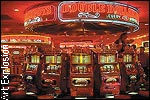

|
|
Casinos bring ill fortune, psychiatrists warn
 A 3-year-old casino in Hull, Que., has caused local residents to gamble more often and lose more money, the Canadian Journal of Psychiatry reports (2000;45:810-5). The study on the impact of availability on gambling also discovered an increase in the number of potential problem gamblers since the casino opened.
A 3-year-old casino in Hull, Que., has caused local residents to gamble more often and lose more money, the Canadian Journal of Psychiatry reports (2000;45:810-5). The study on the impact of availability on gambling also discovered an increase in the number of potential problem gamblers since the casino opened.
Laval University researchers randomly selected and interviewed 457 people from the Hull area before (1996) and after (1997) the Casino de Hull opened. They compared this group with a control group of 423 respondents from Quebec City, which doesn't have a casino. The response rate was 53%. After the casino opened, the proportion of Hull respondents who gambled increased from 13.8% to 60.4%, and the largest average amount lost in 1 day of gambling (casino and other types) increased by 73%, from $89 to $154. In Quebec City during the same period, the number of gamblers decreased (from 26.7% to 22.4% of respondents), as did the largest average amount reported lost in 1 day of gambling (from $33 to $21). The average amount spent by Hull respondents at the casino was $251 annually, while Quebec respondents spent an average of $113 on gambling in general. The extent of the casino's negative impact is indicated by responses from Hull residents before and after it opened. After the opening, 50% more Hull respondents disagreed with its establishment (29.2%) than had disagreed before it opened (19.5%). Lead investigator Robert Ladouceur, a psychology professor, said the results of the study, which was funded by Loto-Québec, weren't unexpected.He was particularly interested in the results concerning problem gamblers. "When they start gambling to win back money they've lost, then that's a problem," he told CMAJ. According to the study, the proportion of at-risk gamblers more than doubled in the year the casino opened (from 3.3% to 7.8%). Signs of an at-risk gambler include playing longer and spending more than planned, and trying to hide the gambling from family members or friends. The study found that the prevalence of probable pathological gambling did not change significantly. However, more Hull respondents said they knew someone who had developed a gambling problem over the past 12 months (28.2%) than did the Quebec respondents (15.6%). In an earlier study on the prevalence of pathological gambling in Quebec,1 Ladouceur found that the prevalence of the problem had increased from 1.2% in 1989 to 2.1% in 1996, a 75% increase. This corresponds with the dramatic increase in legalized gambling in Canada. In 1985 the provinces were given exclusive control over gambling and legalized computer, video and slot devices. By 1997/98, Canadians were spending $6.8 billion annually on some form of government-run gambling activity and the provinces were spending $14 million providing treatment services for problem gamblers. According to a recent CMAJ study (2000;163[1]61-4), the largest public health issues created by widespread gambling are gambling addiction, family dysfunction and underage gambling. "It's a very controversial issue," said Ladouceur. "There are medical problems, social problems and economic problems." — Barbara Sibbald, CMAJ Reference
Copyright 2001 Canadian Medical Association or its licensors |